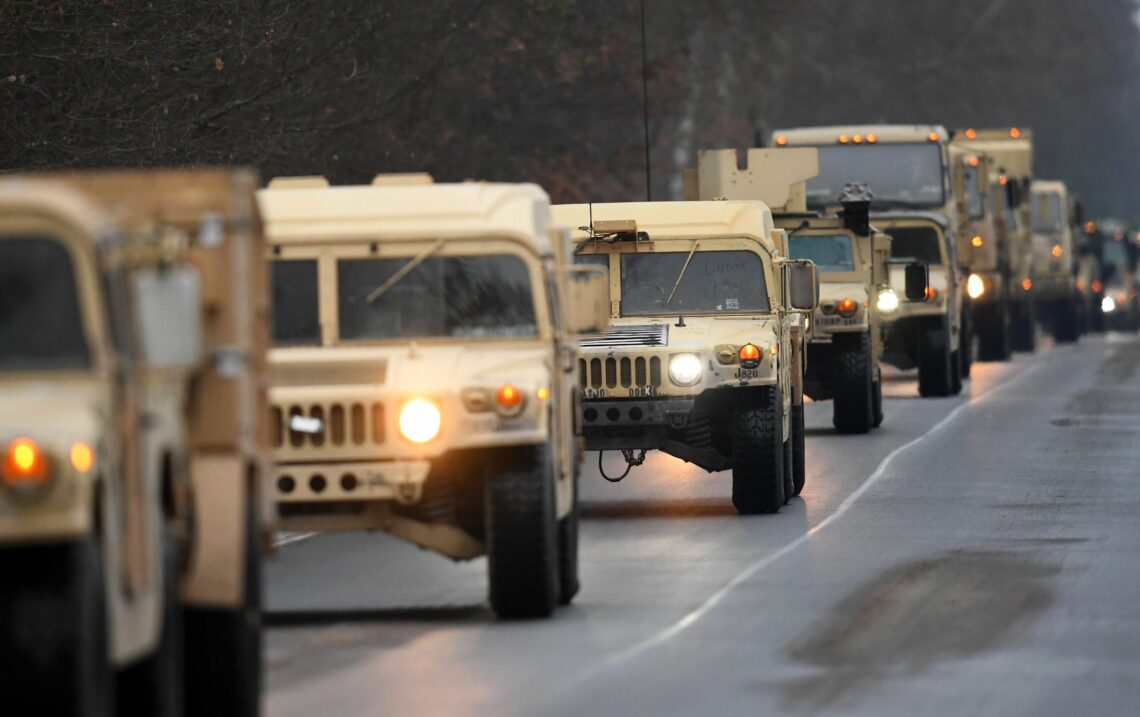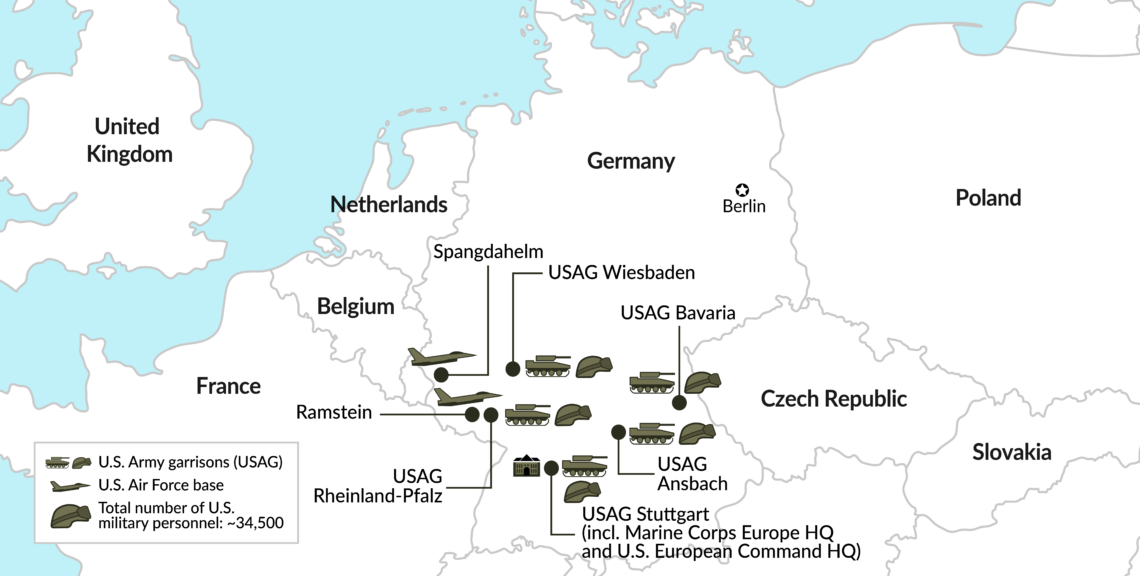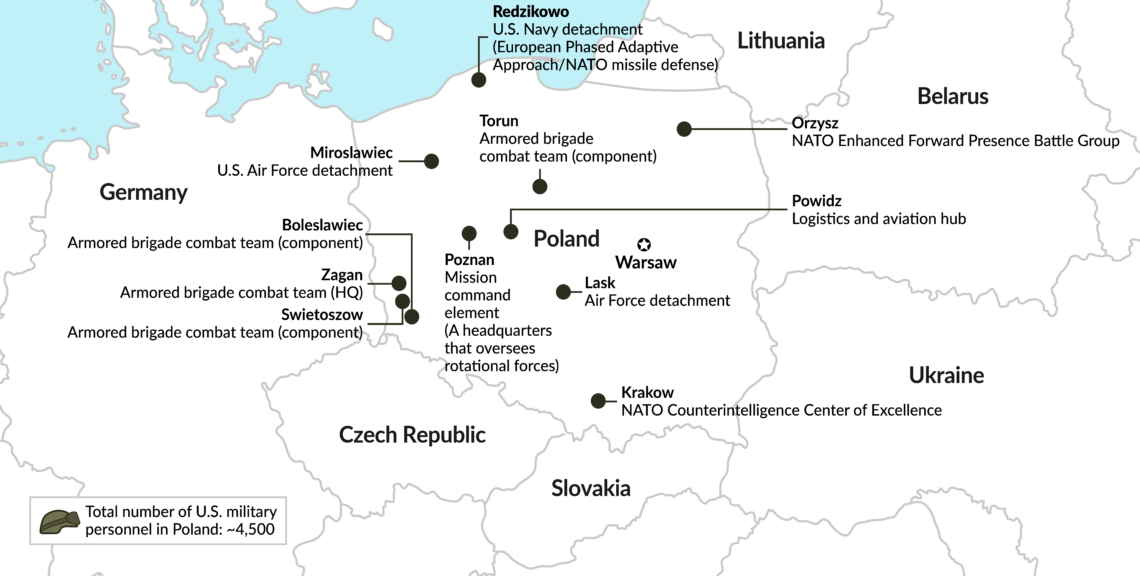The global consequences of relocating U.S. troops in Europe
While relocating the number of U.S. troops in Europe is justified in terms of U.S. interests and policy, the unilateral manner in which it was made threatens NATO unity. If American policies were more cooperative, the West could counter challenges from Moscow and Beijing.

In a nutshell
- Relocating U.S. troops serves several policy goals
- Surprising allies with the move undermined NATO unity
- Russia and China could exploit a reduced U.S. presence
On June 15, United States President Donald Trump confirmed plans to reduce the American military presence in Europe. Four key factors played into the decision: the growing struggle between the U.S. and China, the coronavirus crisis, the dispute between President Trump and European leaders, and the ongoing American presidential campaign.
Some 34,500 American soldiers (and 17,000 civilian employees of the military) are currently stationed in Germany. The Trump administration plans on relocating about 9,500 U.S. troops. According to plans laid out by General Mark Milley, chairman of the Joint Chiefs of Staff, some of the troops withdrawn from Germany would be relocated to Poland and other allied countries, probably mainly on NATO’s eastern flank. Most others would return to the U.S.
It is worth adding that recently, diplomats (including the U.S. ambassadors to Germany and Poland and the German ambassador to Poland) have speculated publicly about the possible withdrawal of American nuclear weapons – B61 nuclear gravity bombs – from Germany and their transfer to Poland. At the same time, President Vladimir Putin endorsed a new deterrence policy allowing Russia to use nuclear weapons not only in retaliation against weapons of mass destruction, but also to de-escalate a conventional conflict.
Washington has been shifting its focus toward the Asia-Pacific region for years.
In turn, China is adopting an increasingly assertive attitude vis-a-vis the West, mainly toward the U.S. The possibility of an armed clash in the Western Pacific is becoming a pressing worry for Washington.
Four factors
The decision to relocate the troops does have a basis in U.S. strategic interests. Washington has been redirecting its political and military focus toward the Asia-Pacific region for several years now. Changes in the global balance of power brought on by the rise of China have made this shift necessary.
President Trump is continuing this “pivot to Asia” famously launched by his predecessor, President Barack Obama. U.S. resources are not unlimited, so to strengthen its military presence in Asia, it must reduce its financial, personal and material involvement elsewhere.
Facts & figures

The second reason behind the drawdown is the need to find funding to deal with the coronavirus crisis. The U.S., like other countries, is implementing relief and recovery programs. Countries frequently draw upon military budgets to finance such initiatives, and for the U.S., Europe is a good place to seek savings. NATO is a team responsibility, so other members of the alliance can somewhat make up for losses in U.S. capabilities. This thinking is in line with the policies of President Trump, who has continually pressed European partners to take on a greater share of the NATO burden.
The third factor is President Trump’s policy goals. Since taking office, he has made American international policy – including security policy – more transactional. For example, he expects allies to pay the U.S. for the service of ensuring international security. In the case of European nations, this meant pushing them to increase their defense spending. At least part of these expenditures could finance American military activity in Europe and the American defense industry supplying NATO armies with advanced weapons systems.
The initiative was partly successful. For example, a large part of the increased Polish defense budget goes toward the purchases of American-built armaments. However, not everyone wants to increase defense spending, at least not at the pace Washington expects.
Facts & figures

Berlin, especially, has resisted calls to increase its security expenditure, which has hindered U.S.-German relations. The relationship between President Trump and Chancellor Angela Merkel is particularly bad. The Covid-19 outbreak has thwarted any plans for increased defense spending in NATO and American hopes for increased arms sales in Europe. These factors likely accelerated the White House’s decision to reduce the American military presence in Europe.
Ahead of the November elections, Mr. Trump wants to show that he is making smart security decisions. This means showing that he has made countering the rise of China a strategic priority. Withdrawing troops from Europe can be spun as part of President Trump’s drive to change European defense policy. Shifting troops to Poland could help gain votes from the significant Polish diaspora in the U.S.However, important questions remain about the practical effects of the move for international security, primarily for Europe and NATO. The reductions carry considerable risks, both in political and strategic terms.
Political risks
The political risks stem from the way the decision was communicated. NATO members’ reactions show they were not consulted and learned about the move only once it was announced. Washington’s decision not to engage in a dialogue with partners on such a crucial matter worsened the already strained confidence between the U.S. and Europe, further weakening NATO unity. Yet it is precisely that unity which is the alliance’s most important political and strategic asset.
The U.S. has surprised its NATO allies before, like when President Obama revealed changes to European missile shield plans on the anniversary of the Soviet invasion of Poland. This time, however, the decision not to consult allies cannot be considered an “unfortunate accident.” Europe’s trust in President Trump is so low that no excuse will be considered credible, nor can the deterioration of transatlantic relations be prevented.
A strong U.S. presence in Europe is crucial both to counter Russia and to support operations in the Middle East.
The relocating U.S. troops from Germany to other countries will also introduce political dissonance within Europe, undermining the alliance’s unity. It creates the impression that the U.S. punishes some allies and rewards others based solely on its own interests. Furthermore, moving troops east will revive intra-European disputes about how to deal with Russia.
Strategic risks
From a strategic point of view, the most important consequences stem from the reduction of the American presence in Europe. The fewer American soldiers in Europe, the weaker NATO is as a transatlantic alliance, especially since there was no strategic compensation announced as a counterweight to the decision (for example in terms of nuclear or missile defense). Also, some officials in the U.S. believe the decision is risky and even counterproductive, since a strong presence in Europe is crucial both to push back against Russia’s neo-Cold War pressure and to support operations in the Middle East.
The only positive for Europe would be the strengthening of its eastern flank. The composition of the forces that are moved there will be crucial. It is likely that the Americans will send staff reinforcements and combat support forces (reconnaissance, antiaircraft, missile, artillery, helicopter) to Poland. Germany would then keep its logistics base intact, allowing it to securely manage the movement of forces and weaponry from North America to Europe in the event of a major emergency.
Relocating U.S. troops may also have considerable consequences for the European Union. Rifts within NATO will undoubtedly filter into the bloc. This could put further strain on the EU, and hurt countries like Poland, which has already lost significant clout within the union.
On the other hand, Europeans’ loss of confidence in the U.S. could push the bloc to strengthen its Common Security and Defense Policy. Even more so since Russia’s pressure on Europe will increase as the U.S. moves its focus away from the continent.
Russia will probably benefit most from President Trump’s decision. Not only does Russia intend to hold its positions in Ukraine and Syria, it has strengthened its presence within its Western Military District, recently adding an armored motorized brigade into the theater.
Focus: China
All in all, President Trump’s decision to reduce and redeploy American troops in Europe raises risks not only for Euroatlantic security but also more broadly across the globe, since the focus of these moves is China.
On one hand, prospects for an increase in American involvement in Asia could worry Beijing. On the other, the weakening ties between the U.S. and its European allies could benefit China. The Chinese are continually expanding their involvement in Europe, meaning a smaller U.S. presence could present opportunities for further gains.
The content of President Trump’s decision – the reduction and relocation of troops – is therefore not as important as the way it was made: unilaterally, causing confusion and division within NATO. The basic problem is not the addition or subtraction of a few thousand American soldiers in Europe, but a loss of credibility and mutual trust in transatlantic relations.
This process is occurring just as transatlantic relations are gaining a new significance for Washington in its great-power rivalry with Moscow and Beijing. This leaves us with two broad scenarios for the American military presence in Europe and the U.S.-China rivalry.
Scenarios
Unilateral approach
In the first scenario, the U.S. will continue to take a unilateral approach to solving its “Europe vs. Asia” security dilemma. Under this scenario, Washington will make more decisions without consulting its European allies. Transatlantic relations and NATO unity will deteriorate further.
Consequently, Russia would see room to put more pressure on Europe. This would be especially dangerous for Central and Eastern Europe, a natural focus of Russian geopolitical aspirations.
Furthermore, European countries and the U.S. would continue to follow uncoordinated policy paths in their relations with China. Washington would risk standing alone in its conflict with Beijing over global hegemony. There will be a new push to strengthen European defense through the development of the EU Common Security and Defense Policy. Divisions within Europe will widen.
Under this scenario, China and Russia would gain strength in the great-power rivalry. The U.S. would not make full use of its capabilities as a global leader.
Multinational cooperation
The second scenario involves more cooperation but paradoxically depends solely on the U.S. It will come to fruition only if Washington tackles China’s rise through Western structures, including agreeing on military actions within the Atlantic alliance. Balancing China would be a collective effort, with the broad involvement of European NATO states.
In this scenario, problems like those surrounding the proposed American troop reduction in Europe would simply not occur. There would be no need for an American military pivot from Europe to Asia because European countries could complement American power. Even if Washington did consider it necessary to make such a pivot, the corresponding moves in Europe would be implemented within a framework of agreements with allies and would therefore not weaken NATO unity. This scenario would bring deeper integration among Western countries and strengthen the U.S. position.
At present, both scenarios seem equally likely. Though the first offers a negative outlook for the U.S. and Europe, political inertia could bring it about. The second hinges on whether the U.S. recognizes Europe’s potential as a partner in the global power struggle.
The most decisive factor in determining which scenario will occur is the November 2020 U.S. presidential elections. The first scenario will be more likely if President Trump is reelected. If former Vice President Joe Biden wins, the second scenario becomes more probable.








